Are you curious about the soothing sound of Tibetan singing bowls? Have you heard stories about their healing effects, but don’t know much else? Wonder no more! This blog post will dive into the world of vocalizing vessels and explore how to use a meditation bowl and its potential health benefits. From understanding what a singing bowl is and where it comes from to learning different methods for using one properly, this guide will have something useful for everyone seeking balance or harmony. The diverse range of applications these ancient instruments possess are sure to surprise—so sit back, relax, and get ready to journey into an incredible realm of chimes that just might change your life.
Unlocking the Mystique of Tibetan Singing Bowls
Tibetan singing bowls have been used for centuries to facilitate spiritual healing and meditation. But what exactly are these mysterious instruments, and why do people use them? Read on to learn more about the history, uses, and various types of Tibetan singing bowls.
What Is a Tibetan Singing Bowl?
A Tibetan singing bowl, also known as a Himalayan bowl, is an ancient bell-shaped instrument made of bronze, brass, or copper. The bowls are traditionally handmade by artisans from India and Nepal using traditional hammering techniques. When struck with a mallet or wand, the bowl emits a calming tone that has long been used for meditation and healing purposes. Many people believe that the sound waves produced by the bowl can have therapeutic benefits such as reducing stress, improving sleep quality, boosting immunity, or increasing creativity.
History of Tibetan Singing Bowls
Tibetan singing bowls are believed to have originated in either India or Nepal in the 8th century A.D., although there is still some debate among scholars as to their exact origin. The earliest known record of a singing bowl dates back to 1027 A.D. when it was mentioned in Buddhist scripture. Since then, they’ve been used by Buddhists and Hindus alike to aid in meditation practices.
Uses of Tibetan Singing Bowls
Today, many people use Tibetan singing bowls for stress relief, relaxation, and spiritual enlightenment. The sound generated by the bowl is said to help induce a state of deep relaxation by calming both the mind and body, allowing practitioners to reach deeper states of meditation. It’s also believed that the vibrations created by the bowl can help promote physical healing by stimulating energy centers in the body known as chakras.
Singing bowls produce sounds when struck or rubbed with a mallet. These sounds are known as “overtones” — vibrations that resonate throughout the bowl and create a harmonious sound. This sound has a calming effect on the listener and can be used to induce relaxation or meditation. It is believed that these sounds stimulate brainwave activity, releasing endorphins that promote feelings of peace and well-being.
-
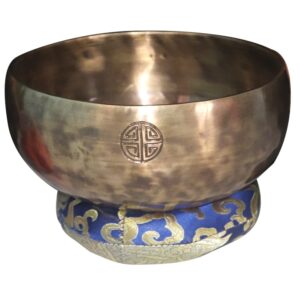 Prosperity Symbol & Tibetan Mantra Copper Singing Bowl
Prosperity Symbol & Tibetan Mantra Copper Singing Bowl -
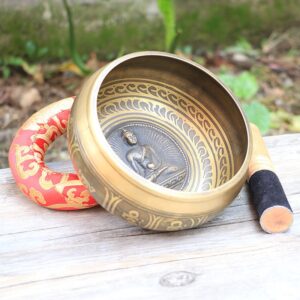 Shakyamuni Buddha Mindfulness Bell
Shakyamuni Buddha Mindfulness Bell -
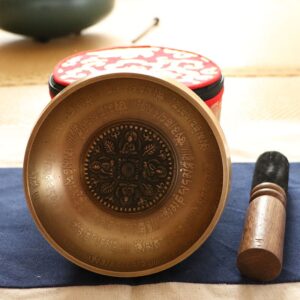 Four Buddha Tibetan Mantra Pattern 12 cm Meditation Bell
Four Buddha Tibetan Mantra Pattern 12 cm Meditation Bell -
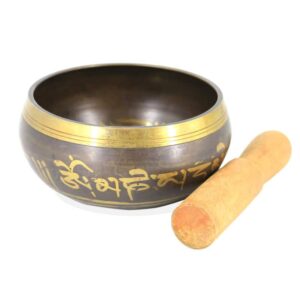 Nepalese Handmade Buddhist Meditation Bowl With Mallet
Nepalese Handmade Buddhist Meditation Bowl With Mallet -
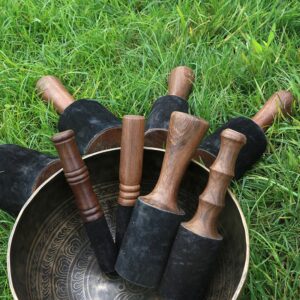 Wooden Leather Hammer Percussion Singing Bowl Mallet
Wooden Leather Hammer Percussion Singing Bowl Mallet -
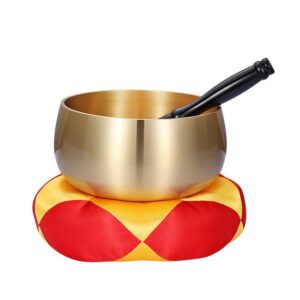 Large Gold Buddhist Standing Bell
Large Gold Buddhist Standing Bell -
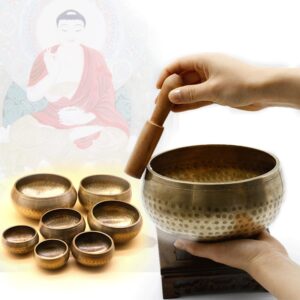 Handmade Meditation Singing Bowl + Mallet + Ring Cushion
Handmade Meditation Singing Bowl + Mallet + Ring Cushion -
 Hand Embroidered Random Color Singing Bowl Ring Cushion
Hand Embroidered Random Color Singing Bowl Ring Cushion -
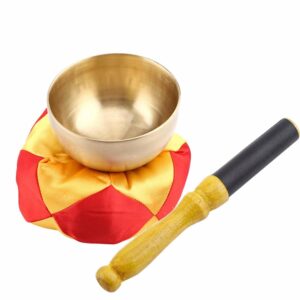 Brass Mindfulness Bell With Wooden Stick And Cushion
Brass Mindfulness Bell With Wooden Stick And Cushion
Singing Bowl vs Standing Bell: What is the Difference?
Have you ever seen a singing bowl or standing bell? These two instruments have similar names, but they are actually quite different.
Singing Bowls
Also known as Tibetan singing bowls, these ancient instruments date back thousands of years. They are typically made from bronze and have a wide, shallow shape with a flat bottom. The sides of the bowl are curved, allowing sound waves to move around it easily. To play a singing bowl, you strike it with a special mallet that creates vibrations which resonate throughout the bowl. The unique sound created by the vibrations is known as “overtones” and is said to be calming and healing for those who listen. Singing bowls are often used in meditation and yoga practices as well.
Standing Bells
Standing bells look like large metal cylinders that stand upright on their own. They also have a flat bottom and curved sides so that sound can move around them easily. Standing bells are larger than singing bowls and usually range from 12-24 inches tall. Unlike singing bowls, standing bells need to be struck with an internal hammer instead of an external mallet; this creates a much louder sound than singing bowls since the metal vibrates against itself instead of against another object like the mallet used for singing bowls. Standing bells are often used in churches or performance spaces since they produce a loud ringing tone that can fill up large areas with sound quickly.
Different Instruments
In conclusion, singing bowls and standing bells may have similar names but they are very different instruments! Singing bowls create soothing overtones when struck with an external mallet while standing bells need to be struck with an internal hammer for maximum volume and resonance. Both instruments can add beauty to your music practice regardless of whether you are using them for meditative purposes or performance purposes!
Can Anyone Use a Tibetan Singing Bowl?
Anyone can use a Tibetan singing bowl! All you need is an open mind and willingness to experiment with the sound waves produced by the instrument. You don’t need any special training or skills to get started; simply hit the rim of the bowl with the mallet and listen to how it sounds! Once you understand how it works, you can try different techniques such as varying your speed or circling around different parts of the rim to create different sounds. If you feel more comfortable with guidance, there are plenty of tutorials available online that provide step-by-step instructions on how to play a Tibetan singing bowl properly. Additionally, many yoga studios offer classes specifically dedicated to learning about these instruments and exploring their therapeutic benefits in greater depth.

Types of Tibetan Singing Bowls
There are many different types of Tibetan singing bowls available today. Some are made from brass or copper, while others are made from quartz crystal or even wood. Each type has its own unique sounds and vibrations, so it’s important to find one that resonates with you personally. Additionally, larger bowls tend to produce lower tones while smaller bowls produce higher tones — so size does make a difference!
The most popular type of singing bowl is the traditional seven-metal bowl. These bowls feature a combination of metals including gold, silver, tin, lead, zinc, iron, and copper. The seven-metal bowls are known for producing high-quality tones that are full and rich in harmonics. They also have a unique look and feel due to their distinctive shape and texture.
Alternatively, there are single-metal singing bowls available as well. These come in various metals such as brass or bronze and can produce bright, clear tones that are perfect for keeping your energy focused during meditation sessions or healing treatments. Single-metal bowls tend to be smaller than seven-metal bowls but still offer excellent sonic qualities with plenty of depth and resonance.
Tibetan singing bowls have been used for centuries as a tool for spiritual healing and meditation practices. Their mysterious sound is said to facilitate relaxation, stress relief, and physical healing through stimulation of energy centers in the body known as chakras — making them an invaluable tool for anyone looking to deepen their meditative practice or simply relax after a long day at work. With so many varieties available, it’s easy to find one that resonates with you!

Do Tibetan singing bowls work and are they worth it?
The sound produced by a Buddhist meditation bowl has been shown to alter brainwaves from beta (normal waking consciousness) to alpha (relaxed alertness). This shift in brainwave activity can lead to increased relaxation, reduced stress levels, improved focus, and even deeper states of meditation. In addition to this physiological effect, some believe that the vibration emitted by the bowl can also heal physical ailments such as headaches or muscle tension due to its ability to stimulate energy points in the body.
Whether or not you should invest in a Tibetan singing bowl ultimately depends on your own personal needs and preferences. If you’re looking for something to aid in your meditation practice or help you relax after a stressful day at work then they could certainly be worth it. However, if you don’t see yourself using one regularly then it might be better to save your money and explore other methods of relaxation instead.
What are the benefits of a Tibetan singing bowl?
Singing bowls offer numerous benefits to those who use them. They can reduce stress and anxiety, improve focus, aid in meditation, and even help to heal physical ailments such as headaches or chronic pain. By vibrating at frequencies that correspond to certain areas of the body, singing bowls can also help to clear energetic blockages within the chakras (the seven energy centers located throughout your body). This helps restore balance within your body’s energy system, allowing it to function more optimally.
A meditation bell offers many benefits to those who use them. Here are just some of the most common benefits:
- Reduces Stress – The sound created by striking a Tibetan singing bowl has been found to reduce stress levels. This is because the sound creates an environment conducive to relaxation and meditation which can help to reduce stress and anxiety.
- Improves Focus – The sound produced by these bowls can also help to improve focus and concentration in individuals who use them regularly. By focusing on the sounds produced by the bowl instead of other distractions, users are able to remain more focused on the tasks at hand.
- Promotes Healing – The vibrations created by striking a Tibetan singing bowl have been found to promote healing both physically and emotionally. The vibrations can help to relieve pain while also helping to create an emotional balance in those who use them regularly.

How to Use a Tibetan Singing Bowl?
Tibetan Singing Bowls are ancient instruments used for meditation, healing, and relaxation. The sound of a singing bowl is both calming and meditative; it is said to clear negative energy from a space and create an atmosphere of peace and well-being. Let’s take a look at how to use a Mindfulness Bell.
Getting Started
First, you will need to choose the right bowl for your needs. There are many different sizes and types of bowls available, so be sure to do some research on which type works best for your specific purpose. Once you have chosen your singing bowl, place it on a flat surface in front of you with the open side facing up. You can also place the bowl on an altar or other sacred space if desired.
Playing Your Bowl
Now that your bowl is in place, it’s time to start playing! Start by gently striking the side of the bowl using a mallet or wooden stick. You may need to experiment with different angles and pressures until you find the perfect sound that resonates with you. As the sound begins to fill the room, focus on taking deep breaths and allowing yourself to relax into the vibrations of the sound waves. If desired, try chanting along with each strike to further enhance your experience.
Creating Positive Energy
Singing bowls create positive energy in any space where they are used. As you play your singing bowl for meditation or relaxation purposes, imagine all the negative energy being released from your body as well as from any people or objects nearby. Visualize this negative energy transforming into positive energy that fills every corner of your room with peace and positivity! With practice and patience, playing singing bowls can become an incredibly powerful part of any spiritual practice or healing journey.
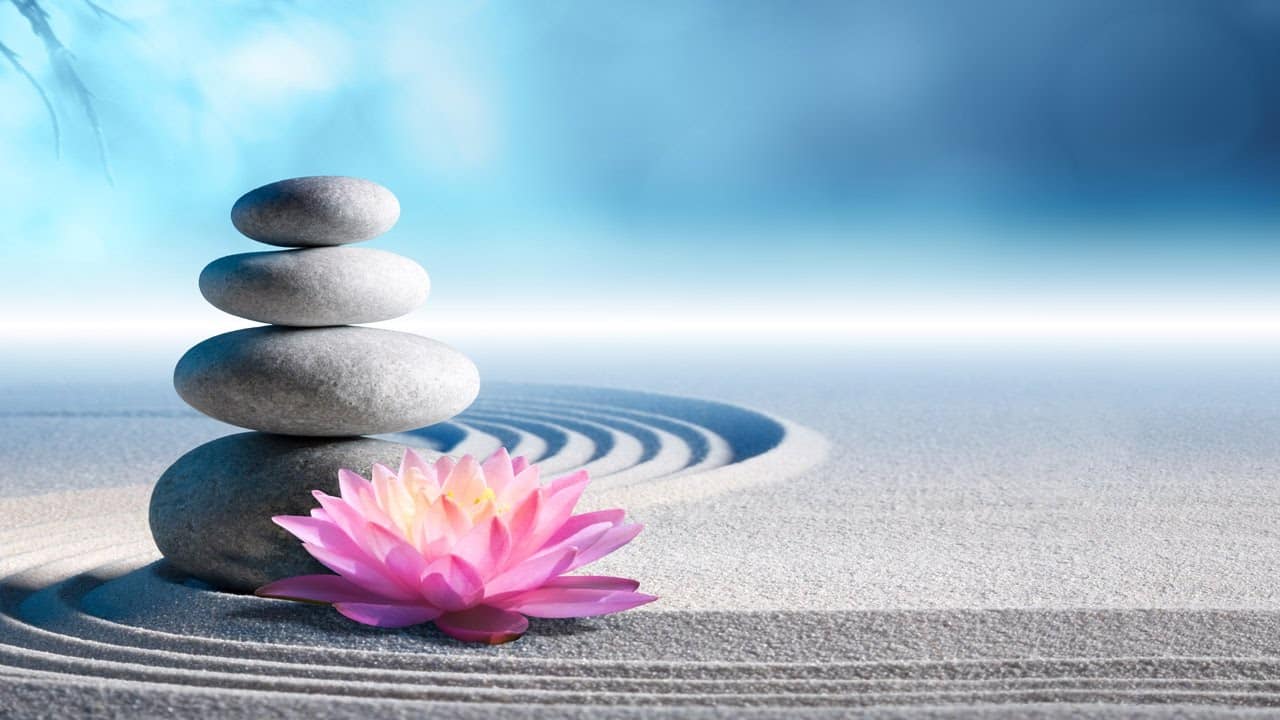
How do you meditate with a Tibetan singing bowl?
Find Your Zen with Tibetan Singing Bowls
Tibetan singing bowls have been used for centuries to bring about peace and tranquility. The soothing sound of the bowl is said to create a meditative state, allowing you to relax and find balance. If you’re looking for a way to escape from your daily stress and find your inner calm, then this ancient practice may be just what you need. Here’s how you can meditate with a Tibetan singing bowl.
Positioning the Bowl
The first step in using a Buddhist meditation bell is positioning it correctly. Place the bowl on an even surface, such as the floor or a table, so that it won’t move around while you play it. Make sure that you are sitting comfortably in front of the bowl and that your hands are relaxed. Once you are in position, take a few deep breaths and allow yourself to settle into the moment.
Striking the Bowl
Once you are settled in front of the bowl, gently strike it with the included mallet. The mallet should be held in one hand while using light pressure to make contact with the edge of the bowl. As soon as you make contact, draw circles around its circumference with gentle strokes from left to right; this will cause vibrations inside the bowl that create soothing tones which will help relax your mind and body. You can also use different techniques such as striking the side or center of the bowl for more variation in sound.
Listen & Reflect
After striking the bowl, listen carefully to its sounds as they reverberate through space and fill your room with peacefulness. Allow yourself to become engrossed by its melody as its vibrations flow through your body and into your soul; give yourself permission to just be present at this moment without worrying about anything else that may be happening outside of this sacred space you have created for yourself within these few moments of solitude. Take some time afterward to reflect on any thoughts or feelings that may have come up during meditation – did anything surprise you? Do any ideas begin to form? Write them down if possible! This will help deepen your experience when using Tibetan singing bowls for meditation moving forward and ensure that each session is unique and meaningful for you personally!
With patience and practice anyone can learn how to meditate successfully with a Tibetan singing bowl — who knows what kind of insights await? Enjoy exploring!

How long should I play a singing bowl?
The answer to this question depends on what you are hoping to achieve by playing your singing bowl. If you are looking for a quick relaxation session, five minutes of playing should be enough. However, if you want to go deeper into meditation or enjoy a more profound experience, it’s best to extend your session to 10 minutes or longer.
It is important to note that there is no “right” length of time for playing your singing bowl. Experiment with different lengths and find out what works best for you! Some people like to set aside 30 minutes per day for their singing bowl practice while others prefer shorter sessions multiple times per day.
It also helps to know how long each note should last when striking your singing bowl. For example, one “complete cycle” of a C4 note (261 Hz) should last about 8 seconds; an E4 note (329 Hz) should last about 6 seconds; and an A4 note (440 Hz) should last about 4 seconds. This will help keep your playing consistent and give you an idea of the optimal amount of time needed for each note.
Tips for Playing Your Singing Bowl
When playing your singing bowl, keep in mind that the goal is not necessarily just to produce sound but rather to use sound waves as a means of achieving mental clarity and emotional balance. Here are some tips on how to get the most out of your practice:
- Find a comfortable seated position that allows you to relax without straining yourself;
- Start by striking the outside rim of your bowl with a mallet — this will create a strong vibration;
- Once it starts ringing, slowly move around the inner rim with your mallet — this will create softer tones;
- Use both hands simultaneously — one hand will hold the mallet while the other rests on top of the bowl;
- Be mindful of how you strike — different techniques will create different sounds;
- Listen carefully — notice how each sound affects your body physically and emotionally;
- Stay present in the moment — focus on breathing deeply and connecting with yourself through meditation;
- Let go — don’t worry about making mistakes or getting it perfect – just enjoy every moment!
What is the power of singing bowls?
The power of singing bowls goes beyond simply providing physical or mental relief; it can also be used for self-empowerment. By channeling positive energy into your life through the use of singing bowls, you can begin to make meaningful changes in your life that will lead to greater fulfillment. Consider using a singing bowl whenever you need an extra boost of confidence or motivation — its vibration will help you stay focused on achieving your goals.
Singing bowl therapy has been around for centuries, but its power still remains relevant today. By resonating with certain frequencies, singing bowls create sound waves which stimulate brainwave activity, helping us relax and find inner peace while clearing energetic blockages within our bodies. On top of this, they offer an added layer of self-empowerment; allowing us to use their vibes as a source of motivation when we need it most! If you’re looking for an easy way to unlock your inner power then consider giving singing bowl therapy a try today!

Can singing bowls open chakras?
The Benefits of Singing Bowls for Chakras Balancing
Singing bowls are ancient instruments used to promote healing and relaxation through sound. But did you know that singing bowls can also be used to open and balance the seven chakras? It’s true! Let’s take a look at what chakras are, how they work, and how singing bowls can help open and balance them.
What Are Chakras?
Chakras are believed to be energy centers in the body that are connected to our physical, emotional, mental, and spiritual well-being. There are seven main chakras located along the spine from the base to the crown of the head. Each one is associated with a different color and has its own unique purpose. When these energy centers become unbalanced, it can lead to physical ailments or emotional issues such as stress or anxiety. Learn about the benefits of Chakra bracelets and how to use them.
How Do Singing Bowls Help Balance Chakras?
Singing bowls produce a rich, harmonic sound when struck or rubbed with a mallet. This sound helps relax the mind while simultaneously stimulating the chakras by opening them up to receive more energy. As the vibrations travel throughout your body, they help clear any blockages in your energy pathways while promoting an overall sense of well-being. By using this technique on each of your seven chakras individually, you can effectively open and balance them all at once.
Using singing bowls for chakra balancing is a simple yet powerful way to restore harmony in your life. Not only does it help clear any energetic blockages you may be experiencing but it also helps increase your awareness of your own body’s energy pathways so that you can better understand how they affect your daily life.
What does listening to Tibetan bowls do to the body?
Tibetan singing bowls produce sound in the form of vibrations. When you listen to a bowl, each part of your body absorbs its vibrations as they travel through your tissues and organs. This is because vibrational energy works on a cellular level; it enters through the cells and helps them restore balance by helping them move back into harmony with their natural state.
The vibrations created by the Tibetan bowls cause two different responses within your body. First, they create a calming effect that allows your body to release any tension or stress it may be holding onto. This relaxed state can bring about feelings of peace and tranquility which promote overall well-being and improved mental health. Secondly, the vibrational energy helps to restore balance within your cells and organs by realigning them with their natural state. This helps improve physical health as well as mental health.
Listening to Tibetan singing bowls has numerous benefits for both physical and mental health. These include reducing stress levels, improving focus and concentration, relieving pain and inflammation, boosting immunity, enhancing creativity, increasing energy levels, balancing hormones, improving digestion, aiding in sleep regulation—the list goes on! The vibrations emitted from these unique instruments also have the power to open up blocked energy pathways which can lead to improved physical performance and enhanced spiritual connections.

What are the symbols on a Tibetan singing bowl?
Have you ever wondered what the symbols on a Tibetan singing bowl mean? For centuries, these bowls have been used to promote relaxation, meditation, and mindfulness. But what is the significance of the symbols that adorn these unique instruments? Let’s take a closer look.
Tibetan singing bowls are believed to be between 800 and 2,000 years old. They are made from seven different metals, which each represent a planet in our solar system. The artisan who creates the bowl will etch various designs into the metal surface; some of these designs are symbolic of Buddhist deities, while others are meant to evoke feelings of peace and calm.
The most common symbol seen on a Tibetan singing bowl is the “Om” symbol. This symbol represents peace, harmony, and balance; it is also associated with spiritual awakening and enlightenment. If you look closely at a Tibetan singing bowl, you may also notice a lotus flower design—the lotus flower is often seen as a sign of purity and new beginnings. The “Wheel of Dharma” or “Wheel of Life” is another common symbol found on Tibetan singing bowls; this wheel represents karma and rebirth. Finally, there may be symbols associated with one or more Buddhas; depending on which Buddha it is associated with, this could represent compassion or wisdom.
Tibetan singing bowls have been used for hundreds of years for healing purposes as well as for meditation and mindfulness practice. The symbols that adorn these beautiful instruments carry deep spiritual meaning: from Om to lotus flowers to wheels, each symbol has its own story to tell about the history behind these ancient instruments.
-
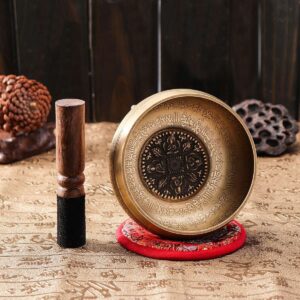 Tibetan Buddhist Chakra Meditation Singing Bowl with Hammer & Mat
Tibetan Buddhist Chakra Meditation Singing Bowl with Hammer & Mat -
 Prosperity Symbol & Tibetan Mantra Copper Singing Bowl
Prosperity Symbol & Tibetan Mantra Copper Singing Bowl -
 Shakyamuni Buddha Mindfulness Bell
Shakyamuni Buddha Mindfulness Bell -
 Four Buddha Tibetan Mantra Pattern 12 cm Meditation Bell
Four Buddha Tibetan Mantra Pattern 12 cm Meditation Bell -
 Nepalese Handmade Buddhist Meditation Bowl With Mallet
Nepalese Handmade Buddhist Meditation Bowl With Mallet -
 Wooden Leather Hammer Percussion Singing Bowl Mallet
Wooden Leather Hammer Percussion Singing Bowl Mallet -
 Large Gold Buddhist Standing Bell
Large Gold Buddhist Standing Bell -
 Handmade Meditation Singing Bowl + Mallet + Ring Cushion
Handmade Meditation Singing Bowl + Mallet + Ring Cushion -
 Hand Embroidered Random Color Singing Bowl Ring Cushion
Hand Embroidered Random Color Singing Bowl Ring Cushion
How can you tell if a singing bowl is good quality?
In order to experience the full benefits of a singing bowl, it is important to ensure that you purchase one of good quality. Here is a quick guide on how to tell if a singing bowl is good quality or not.
Material
The material used for making singing bowls varies depending on their origin. The most sought-after singing bowls are those made out of seven metals—gold, silver, iron, lead, tin, copper, and mercury—which are believed to impart various healing qualities. Some modern-day singing bowls may be made from brass or bronze as well. The higher the quality of metal used in making the bowl, the better its sound will be.
Shape and Size
Singing bowls come in various shapes and sizes depending on their purpose. Generally speaking, larger bowls have a deeper resonance while smaller ones have higher-pitched tones. If you are looking for an ornamental piece for your home décor then size may not be as important as aesthetics; however, if you plan to use the bowl for sound healing then it will be important to consider the shape and size carefully in order to get the desired effect.
When shopping for a Tibetan singing bowl it’s important to consider the size of the bowl you want. Generally speaking, larger bowls generate deeper sounds while smaller ones will create higher-pitched tones. So depending on what type of sound you’re looking for you may need to experiment with different sizes until you find one that resonates with you (both literally and figuratively).
Weight
When it comes to weightier matters (literally), heavier is always better when it comes to singing bowls. A good quality bowl should feel quite substantial when held in your hand; this indicates that more metal was used during its production which translates into better sound quality when played. Heavier bowls also tend to vibrate more easily than lighter ones which make them ideal for creating strong harmonic overtones when struck with a mallet or rubbed with a suede striker/wand.
Conclusion
In short, there are several things you should look out for when shopping around for a high-quality singing bowl: materials used (preferably seven metals), shape and size (depending on what you intend to use it for), and weight (the heavier the better). By keeping these criteria in mind when making your choice you can ensure that you get a good quality bowl that will provide years of soothing sonic pleasure!

What are the side effects of Tibetan singing bowl?
One potential side effect associated with using Tibetan singing bowls is that they can be overstimulating for some people. This is especially true if you are already feeling overwhelmed or anxious when you begin your session. If this happens, it may be best to stop playing the bowl until you feel more relaxed or at least take a break between each song so that you don’t become overly stimulated.
Additionally, some people may find that their hands become sore after playing the bowl for an extended period of time due to the vibrations created by striking it repeatedly with the mallet. To avoid this issue, make sure to use proper hand placement when playing and take frequent breaks if needed.
As long as they are used responsibly, Tibetan singing bowls can be a great tool for promoting relaxation, reducing stress levels, and even aiding in meditation practices. While there are some potential side effects associated with using them—such as overstimulation or hand soreness—these can usually be avoided by taking regular breaks or ensuring proper hand placement when playing the bowl. So if you’re looking for a way to reduce stress levels or create a peaceful atmosphere for meditation, give Tibetan singing bowls a try! You might just find yourself pleasantly surprised at how effective they can be!
Final Words
Tibetan singing bowls have become increasingly popular in recent years, with many people appreciating their calming effects. Many individuals use them to reduce stress and promote relaxation, while others may rely on them as part of a regular spiritual practice. Whether you are just attempting to get through a difficult day or you are looking to further your meditation experience, using a Tibetan singing bowl is sure to bring some powerful results. The best way to understand and appreciate this amazing tool is to try it yourself – let the vibrations wash over you and give yourself permission to take some precious moments away from your day-to-day life and explore something new. With its ancient roots, beautiful sound, and countless possible uses and applications, a Tibetan singing bowl can truly be an incomparable experience that can help enhance your life.

